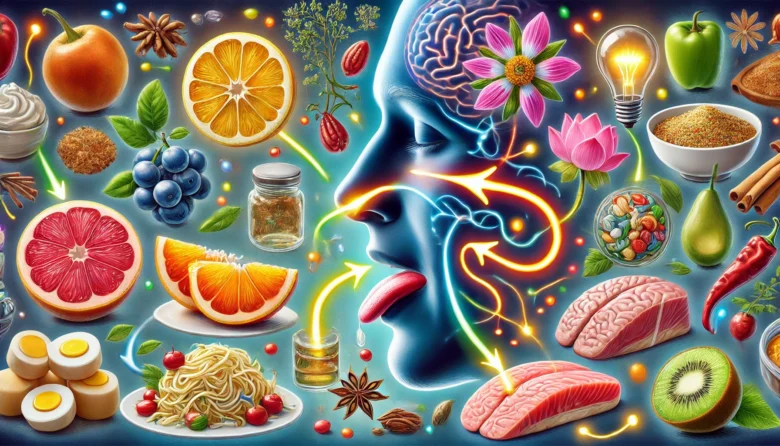Fun Fact: Did you know that up to 80% of what we perceive as taste is actually due to our sense of smell?
We often take our senses of taste and smell for granted, but they play a vital role in how we experience the world around us. Whether it’s the comforting aroma of spices in a curry or the sharp tang of a lemon, these two senses are more connected than most people realize. In this blog, we’ll dive into the science of sensory perception, focusing on taste and smell—how they work, why they’re so important, and the fascinating ways they shape our experiences.
How Do Taste and Smell Work?
To understand taste and smell, we first need to look at how our body perceives them. These two senses fall under the category of “chemical senses,” meaning they detect chemicals in the environment and translate them into signals our brain can understand.
Taste: More Than Just the Tongue
Taste (or gustation) is perceived primarily through taste buds, which are located on the tongue, the roof of the mouth, and even the throat. Each taste bud contains receptor cells that are sensitive to five basic tastes:
Sweet – Signaled by sugars and some amino acids.
Sour – Activated by acids like citric acid in lemons.
Salty – Triggered by salts, mainly sodium chloride.
Bitter – Often a response to alkaloids like caffeine or certain plants.
Umami – The savoury taste often associated with glutamates, found in meats and aged cheeses.
It’s a common misconception that the tongue is divided into taste zones. All areas of the tongue can detect all five tastes, though some regions may be slightly more sensitive to certain tastes.
Interestingly, research shows that our taste preferences are influenced by our genetics. Some people are more sensitive to bitter tastes, which is why certain foods, like broccoli or coffee, might taste more intense to them.

Smell: The Unsung Hero of Flavor
Smell (or olfaction) plays a much larger role in how we experience flavours than many people think. When we chew food, aromas are released that travel up to the olfactory receptors in our nose. This process is called retronasal olfaction. The fusion of taste and smell creates the complete experience of flavour. Without smell, foods can taste bland or one-dimensional—this is why things don’t taste as good when you have a cold!
The olfactory receptors in the nose detect thousands of different odour molecules. These receptors send signals to the brain’s olfactory bulb, which processes and identifies the smells. What’s fascinating is that smell is closely linked to memory and emotion. You might find that certain smells, like the scent of rain or freshly baked bread, instantly transport you to a specific moment in your life.
Why Are Taste and Smell Important?
Both senses serve more than just aesthetic purposes; they are essential for survival. Taste helps us detect and avoid potentially harmful substances. For example, bitter and sour tastes can signal spoiled food or toxic substances, while sweet tastes help us identify energy-rich foods.
Smell, on the other hand, helps us detect danger, such as smoke or gas leaks, and can also enhance our social and emotional interactions. The smell of a familiar perfume or a home-cooked meal can evoke powerful feelings of comfort and connection.
The Science of Sensory Interaction
While taste and smell are separate senses, they are deeply interconnected. This interaction is known as sensory integration. When you bite into an apple, your taste buds pick up the sweetness, but your sense of smell detects the apple’s aroma, giving you a complete sensory experience.
Interestingly, research shows that these senses can also influence each other. For instance, a pleasant smell can make food taste better, while an unpleasant odour can make something taste worse—even if the flavour hasn’t changed.
Case Study: The Role of Smell in Wine Tasting
Wine tasting is a perfect example of how crucial smell is to flavour perception. In fact, professional sommeliers rely heavily on their sense of smell to distinguish between different wines. When you swirl a glass of wine, you’re releasing volatile compounds that stimulate your olfactory receptors. These aromas help identify the wine’s complexity, from fruity notes to earthy tones.
How Our Taste and Smell Change Over Time
It’s important to note that our senses of taste and smell change throughout our lives. Children often have more sensitive taste buds, which is why they might dislike certain strong flavours like bitter vegetables. As we age, the number of taste buds decreases, and our sense of smell can diminish, which can affect how we enjoy food.
Anecdote: The Mystery of “Cilantro Tastes Like Soap”
Have you ever heard someone say that cilantro (also known as coriander) tastes like soap? This isn’t just a strange preference—it’s actually linked to genetics! Some people have a genetic variant that makes them more sensitive to aldehyde compounds found in cilantro, which also happen to be found in soap. For these individuals, cilantro has an unpleasant, soapy taste, while others might find it refreshing and citrusy.
Sensory Disorders: When Taste and Smell Go Wrong
While most of us enjoy the full range of taste and smell, some people suffer from sensory disorders that can diminish or distort these senses.
Ageusia is the loss of taste perception, while anosmia refers to the loss of smell.
Dysgeusia and parosmia are conditions where taste or smell are distorted, often resulting in unpleasant sensations.
COVID-19 brought attention to these sensory disorders, as many people who contracted the virus reported a temporary or long-term loss of taste and smell. For many, this was more than just an inconvenience—it dramatically impacted their quality of life, as eating became less enjoyable, and social interactions were affected.
Conclusion: Appreciating the Little Things
Taste and smell may seem like minor details in our everyday lives, but they are deeply connected to our experiences and well-being. From the simple pleasure of enjoying your favourite meal to the subtle ways they protect us from harm, these senses are essential. The next time you savour a delicious dish or inhale the aroma of your morning coffee, take a moment to appreciate the science behind your sensory perception!
Author’s Note
As someone fascinated by how our bodies and minds work, exploring the connection between taste and smell has been an exciting journey. I hope this blog helps you see these everyday experiences in a new light. If you’re interested in diving deeper, I’ve included some additional resources below.
G.C., Ecosociosphere contributor.
References and Further Reading
- The Role of Olfaction in Flavor Perception
- The sense of smell – Eschooltoday. https://eschooltoday.com/learn/the-sense-of-smell-2/





Comments
of course like your website but you have to check the spelling on several of your posts A number of them are rife with spelling issues and I in finding it very troublesome to inform the reality on the other hand I will certainly come back again